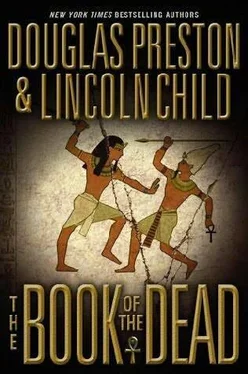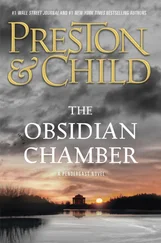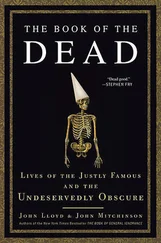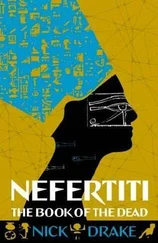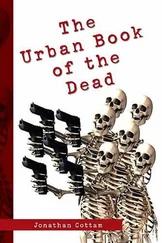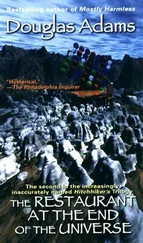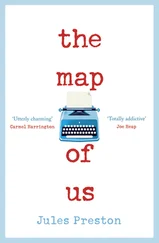She turned to the next documents: lengthy police reports from one Detective Sergeant Gerald O’Bannion, handwritten in the beautiful script once standard in America. She scanned the reports with interest, then reviewed the mass of papers beyond: memos and letters to city officials and the police in what appeared to have been a successful effort to squelch the real story described in the police reports and keep it from the press. She paged through the documents, fascinated by the tale they told, finally understanding why the museum had been so anxious to shut down the tomb.
She jumped when a faint tone announced that the vault door was opening. Turning, she saw the sleek, dapper form of Adrian Wicherly, leaning against the metal jamb, smiling.
“Hello, Nora.”
“Hi.”
He straightened up, giving his suit a little tug, adjusting his already perfect Windsor knot. “What’s a nice girl like you doing in a dusty old place like this?”
“Have you signed in?”
“Je suis en règle,” he said with a little laugh, coming forward and leaning over her shoulder. She could smell expensive aftershave and mouthwashed breath. “What have we here?”
The archivist looked in. “Ready to be locked in?”
“Do. Lock us in.” And Wicherly winked at Nora.
“Why don’t you take a seat, Adrian?” she said coolly.
“Don’t mind if I do.” He pulled an old wooden chair up to the table, dusted the seat with a swipe of a silk handkerchief, and eased himself down.
“Any skeletons in the closet?” he asked Nora, leaning in.
“Definitely.”
Wicherly was a bit too close and Nora edged away as subtly as she could. Although Wicherly had initially come across as the acme of good breeding, lately his smarmy winks and fingertip caresses had led her to believe he was operating more on the glandular level than she had initially thought. Still, things had remained on a professional level and she hoped they would continue that way.
“Do tell,” Wicherly said.
“I’ve just skimmed the documents, so I don’t have the full story, but here it is in brief. On the morning of March 3, 1933, the guards arriving to open the tomb realized it had been broken into. A lot of objects were vandalized. The mummy was missing, later found in an adjacent room, badly mutilated. When they looked in the sarcophagus, they found a different body in it. A freshly murdered body, as it happened.”
“Amazing! Just like that fellow, what’s-his-name. DeMeo.”
“Sort of, except the resemblance stops there. The body belonged to Julia Cavendish, a wealthy New York socialite. She just happened to be the granddaughter of William C. Spragg.”
“Spragg?”
“He was the man who bought the tomb from the last Baron Rattray and had it shipped to the museum.”
“I see.”
“Cavendish was a patroness of the museum. She appears to have had a rather notorious reputation as-well, for want of a better term, a female rake.”
“How so?”
“She went to bars and picked up young working-class men-longshoremen, stevedores, and the like.”
“And did what with them?” Wicherly asked with a leer.
“Use your imagination, Adrian,” she said dryly. “Anyway, her body had been mutilated, but the papers don’t offer details.”
“Strong stuff for the thirties, I should say.”
“Yes. The family and the museum were desperate to cover it up-for different reasons, of course-and it seems they managed quite nicely.”
“I imagine the press was a bit more cooperative in those days. Not the muckraking chaps we have today.”
Nora wondered if Wicherly knew her husband was a reporter. “Anyway, the investigation into Cavendish’s murder was still ongoing when it happened again. This time the mutilated body belonged to Mongomery Bolt, apparently a collateral descendant of John Jacob Astor, a remittance man and a sort of black sheep in the family. The tomb was now being guarded at night, but the murderer sapped the guard before dumping Bolt’s body in the sarcophagus. A note was found on the body. There’s a copy of it in this file.”
She pulled out a yellowed sheet. On it was an Eye of Horus and several other hieroglyphs. Wicherly looked at it in bemusement.
“‘The Curse of Ammut Strikes All Who Enter,’” he intoned. “Whoever wrote this was ignorant. The chap barely knew his hieroglyphs. They aren’t even drawn properly. A crude fake.”
“Yes. They realized that right away.” She turned over some more papers. “Here’s the police report on that crime.”
“The plot thickens.” Wicherly winked, edged his seat closer.
“The police took notice of the link to John Jacob Astor. He’d helped finance the installation of the Tomb of Senef. The police began to wonder if someone wasn’t taking revenge on those responsible for bringing the tomb to the museum. Naturally, their suspicions fell on the Bey of Bolbassa.”
“The fellow who claimed the tomb was cursed.”
“Right. He’d gotten the newspapers all stirred up against the museum. Turns out he wasn’t even a real bey-whatever that is. There’s a report here on his background.”
Wicherly picked it up, sniffed. “Former carpet merchant, made a lot of money.”
“Again, the museum, along with the Astor family, was able to successfully quash any publicity-except it was impossible to stop the rumors circulating inside the museum itself. In time, the authorities established that the Bey of Bolbassa had returned to Egypt just before the killings, but they suspected he had hired operatives in New York. If he did, though, they were too clever to get caught. And when the third killing occurred-”
“Another?”
“This time it was an elderly lady who lived in the neighborhood. It took them a while to figure out the connection-turns out she was distantly descended from Cahors, the man who originally found the tomb. By now, the museum was boiling with rumors, and they were spreading to the general populace. Every crank spiritualist, medium, and tarot-card reader was converging on the museum, and New Yorkers were only too eager to believe the tomb was really cursed.”
“Credulous fools.”
“Perhaps. In any case, it just about emptied the museum. The police investigation wasn’t going anywhere, and so the museum decided to take preemptive action. Using the pretext of the construction of the 81st Street station pedestrian tunnel, they closed the tomb and sealed it up. The killings stopped, the rumors gradually died down, and the Tomb of Senef was mostly forgotten.”
“And the murder cases?”
“Never solved. Although they were convinced the bey was behind them, they couldn’t get proof.”
Wicherly rose from his chair. “That’s quite a story, Nora.”
“It certainly is.”
“What are you going to do with it?”
“On the one hand, it might make an interesting sidebar to the history of the tomb. But I have a sense the museum wouldn’t be too keen on publicizing it, and I’m not sure I’d like to, either. I’d rather focus on the archaeology, on teaching people about ancient Egypt.”
“I agree with you, Nora.”
“There’s another reason, maybe even more important. This new murder in the museum-it has some resemblances to the old ones. People will talk, rumors will start.”
“Rumors have already started.”
“Well, yes. I’ve been hearing quite a few myself. At any rate, we don’t want anything derailing this opening.”
“Very true.”
“Good. I’ll write Menzies a report, with our recommendation that none of this is relevant and that it shouldn’t be publicized.” She closed the folder. “That settles it, then.”
There was a silence. Wicherly had risen from his seat and was once again standing behind her, glancing down at the scattered papers of the file. He reached over and picked one up, perused it, put it back down. She felt his hand on her shoulder and stiffened.
Читать дальше
